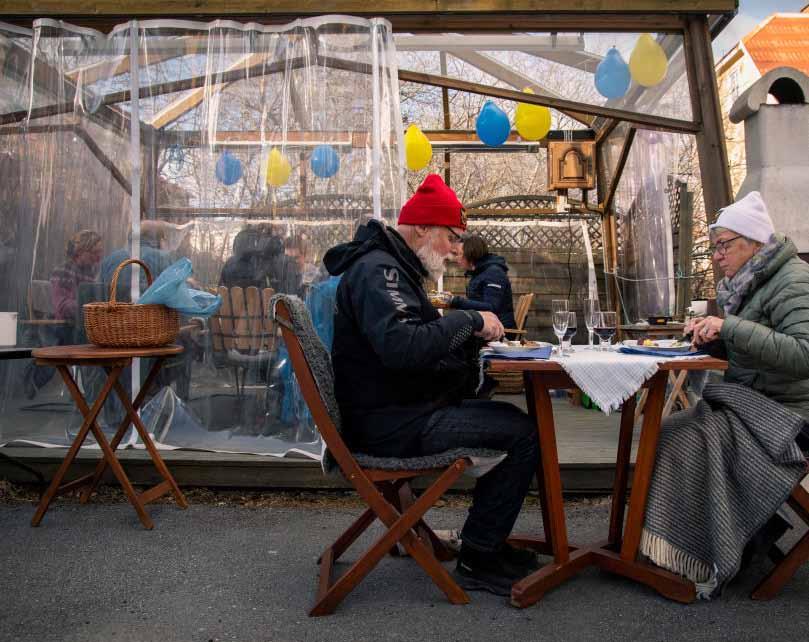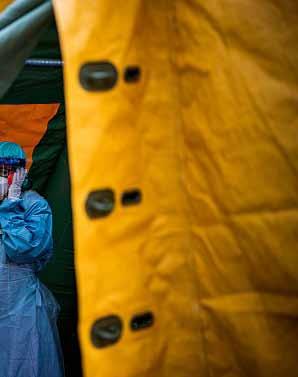
12 minute read
Sweden’s Coronavirus Strategy Should Not Be the World’s
But Aspects of It Are Worthy of Consideration
by Josh Michaud
No country has been as simultaneously praised and criticized as Sweden has for its response to the novel coronavirus. Each day brings new discussion, much of it heated, of the merits of the Swedish model. In general, opinions fall into one of two camps: those saying the country has found a uniquely effective way to address the pandemic (as Nils Karlson, Charlotta Stern, and Daniel B. Klein have argued in these pages) and those saying it has found a uniquely reckless way of endanger-
A senior couple eat dinner keeping distance from the rest of their family despite the fear around the world of spreading the Coronavirus (COVID19-) on April 2020 ,18 in Ostersund, Sweden. (Getty)
ing the health of its people. What both sides agree on is that the Swedish experience holds lessons for others, either as a model to be emulated or as a cautionary tale. At the end of the day, however, .the two camps are mostly talking past each other
While there is some debate about what the “Swedish model” actually is, many would likely agree there are two primary differences between that country’s response and responses of other Western countries. One is that the Swedish government has taken a remarkably hands-off approach to managing the pandemic—an approach from which other countries could learn as they prepare for the long haul. The other characteristic that distinguishes Sweden’s response is its undeclared but widely acknowledged objective of achieving herd immunity. Here, other governments would do well to heed warning signs and be wary of following .Sweden’s lead
A LIGHTER TOUCH
Most European countries imposed lockdowns and other coercive measures to slow the spread of the virus—but not Sweden. Rather than issuing mandatory restrictions on social or economic activity, the Swedish government placed responsibility for risk reduction on individuals and businesses. The government released guidelines and recommendations on how individuals could help flatten the curve by hand washing, physical distancing, and avoiding nonessential travel. But it didn’t threaten penalties or incarceration if recommendations weren’t followed. There were no “shelter-in-place” orders and no need to determine which workers were “essential” and which ones were “nonessential.” Children remained in school (though universities closed) and people continued to congregate in restaurants, parks, and other pub- .lic spaces
Even without heavy-handed threats from the government, people in Sweden have for the most part followed recommendations and changed their behavior. Google mobility records indicate that people in the county that surrounds the capital, Stockholm, have reduced their trips to retail and entertainment establishments by between 20 and 40 percent and their use of public transit by between 30 and 40 percent during the pandemic,
roughly equivalent to the declines seen in neighboring countries. The government sees this more relaxed, less coercive policy as more prudent and durable, because Swedes have largely avoided the fatigue and stress that the citizens of other nations have endured under lockdown. Polls indicate that a large majority of Swedes support their government’s management of the pandemic so far and express appreciation that they can maintain some .semblance of normalcy in their lives
By contrast, those who have endured lengthy periods of lockdown in other countries are grappling with a mounting social and emotional toll. Social isolation and loneliness resulting from distancing measures can exacerbate mental health issues. In a recent poll of American adults by the Kaiser Family Foundation, 45 percent of respondents reported that their mental health had suffered from pandemic-related stress. In countries such as the United States and the United Kingdom, many acknowledge the need for social distancing but also express growing fatigue with restrictions. Policies that help alleviate these pressures without endangering public health are worthy of serious consid- .eration
One way some countries under lockdown might safely follow Sweden’s lead is by allowing people to access public parks and other open spaces. Swedes have also enjoyed outdoor seating in restaurants, with adequate physical distancing—another low-risk activity that might be responsibly replicated. Overall, there is a growing consensus that different environments have different risk profiles for coronavirus transmission, so places not in the midst of an uncontrolled outbreak can safely
olitics P
consider a more flexible approach—one that eases restrictions while encouraging hygienic behaviors .such as the use of masks or face shields in public
Any relaxation of social-distancing measures would of course have to be pursued carefully and strategically and coupled with adequate public education as well as monitoring to ensure adherence to guidelines. Sweden may have a leg up on other countries when it comes to compliance with voluntary guidelines because of its unusually high levels of public trust. Still, there is likely room outside Sweden for a more nuanced approach that will make the pandemic easier to manage in the .long run

A HIGH-STAKES BET
Although Sweden’s laissez-faire approach to social distancing is worthy of consideration by other countries, its apparent pursuit of herd immunity is probably not. Some Swedish officials have denied that herd immunity is the government’s eventual goal, but the country’s leading state epidemiologist and other top officials have cast some doubt on those denials by repeatedly claiming that Sweden is rapidly approaching herd immunity, spurred along by its relaxed distancing policies. In April, for instance, representatives from Sweden’s public health agency estimated that one-third of the people in Stockholm would be immune by the beginning of May. More recently, authorities estimated that between 20 and 25 percent of Stockholm County’s 2.4 million residents were already immune as of early May
and that Stockholm would reach herd immunity, with between 40 and 60 percent of the city’s population exposed and protected with antibodies, by .mid-June
Official proclamations notwithstanding, there is little reason to believe that Sweden currently enjoys a particularly broad level of population immunity. For starters, scientists have yet to conclusively determine that prior infection really confers immunity or, if it does, for how long (though recent evidence is encouraging on this front). And some of the government’s immunity estimates are modeled extrapolations, derived through questionable methods. Independent modelers believe four percent to seven percent of the country’s population has been infected to date, not much different from their estimates for France, Italy, Spain, and the United States, which range from four to nine percent. For the city of Stockholm, two seroprevalence studies conducted by Swedish universities in April and early May found that 7.5 percent and ten percent of people tested there
A medical staffer at Sophiahemmet hospital talks on a cell phone inside a tent for testing and receiving potential coronavirus COVID19- patients on April 2020 ,7 in Stockholm. (Getty)
especially those in elder care homes. According to the government, the mortality rate in April for those over 60 years old increased by 25 percent, and it increased by 50 percent or more for those over 80 years old. Immigrant communities have also been hard hit, recording the highest infection .rates in Stockholm

had SARS-CoV-2 antibodies. Finally, based on the reported deaths in Stockholm County (1,855), and Sweden’s own COVID-19 infection fatality rate estimate (0.6 percent), it is possible to generate a crude estimate that 12 or 13 percent of residents in the Stockholm region have been infected to date. Considering that the seroprevalence estimates from other hard-hit cities such as Wuhan (ten percent), London (ten percent), and Madrid (11 percent) are in a similar range, the official estimates that Stockholm might be approaching 40 to 60 percent immunity by June are even harder .to believe
What limited progress the country has made toward broader immunity, moreover, has come at serious cost to the health of at-risk populations, including the elderly, immigrants, and minorities. According to a New York Times analysis, Stockholm suffered more than twice the usual number of deaths last month compared with a baseline from previous years. These deaths, due to COVID-19, have been heavily concentrated among the elderly, Proponents of the Swedish model contend that the country’s relatively higher death rate will look better with time, especially if there is a second wave of the disease. This is a high-stakes bet, and it assumes that many must die now in order to protect the country in the future. But Sweden’s COVID-19 death toll has soared without bringing the country much closer to herd immunity, at least not in light of the available evidence. In countries that lack Sweden’s advantages, the human cost of a push to- .ward herd immunity would likely be even higher
Sweden’s total death rate from the pandemic, about 366 per one million people, falls somewhere in the middle of the pack compared with rates in other Western countries: many times higher than Norway and Denmark, higher than the United States and the Netherlands, but lower than Italy, Spain, and France. This is despite the fact that Sweden has excellent health services, low population density, few crowded households, and relatively low rates of chronic conditions known to be risk factors for severe COVID-19 .illness and death
Four months into the pandemic, there is little question about the best way to guard against unnecessary COVID-19 deaths: widespread testing, effective contact tracing, rapid isolation, and extra efforts to ensure the safety of the elderly and other at-risk populations. Sweden could do a better job of incorporating the latter measure into its response—and other countries could continue to implement all of them with or without strict lockdowns. The lesson to be drawn from the Swedish experience may well be that a more rational approach to social distancing need not go hand in hand with a drive toward herd immunity that re- .sults in preventable deaths
This article was originally published on ForeignAf- .fairs.com
pinion o
Gebran Bassil›s Dispute with Hezbollah
by: Elie Fawaz
When the Lebanese Civil War ended, Rafic El Hariri set out to bring back normal life to Lebanon, and of course, he started with the political apparatus of the country. As such he made a constitutional return to the sectarian political system. This time, however, Lebanese Christians were unsatisfied with these arrangements outlined in the Taif Agreement, as they felt little attachment to the leaders who were representing them in office. They did not feel that President Hrawi represented them, nor were they sold on Michel Murr, who was at the time the most powerful Orthodox politician. This frustration from the Christians stemmed from the fact that their most powerful leaders during the civil war, Aoun and Geagea, were exiled and imprisoned, respectively. At the time, the late Maronite Patriarch, Nasrallah Sfeir, and Archbishop of the Beirut Greek Orthodox Church, Elias Odeh, tried to express the grievances of the Lebanese Christian communities to pillars of the state and the Syrian guardianship. However, both Lebanese and Syrian representatives did not take such grievances into consideration. The new constitutional government established new councils and ministries, which would be divided among the sects of Lebanon. For instance under the new arrangements, the Shiites would have control over the Council of the South while the Druze would be in charge of the Ministry of the Displaced and the Sunnis managed the Council for Development and Reconstruction. Hundreds of millions of dollars were spent on these councils, but this high price tag did not reflect the political efficacy of said councils. Nevertheless, this arrangement remained until the assassination of Prime Minister Hariri in 2005. Following the assassination, or because of it, the Syrian army withdrew from Lebanon. Meanwhile, Samir Geagea was released from prison and General Aoun returned from his Parisian exile. General Aoun’s return to Lebanon undoubtedly came as a result of a coordinated effort between Hezbollah and Syria. In 2006, Michel Aoun signed an agreement with Mar Mikhail and Hezbollah and it was at that moment in which he joined the opposition alliance of minorities. By doing so, the general abandoned the principles he was preaching during his Parisian exile, principles that included the existence of a strong civilian state and a national army’s monopoly over weaponry. Moreover, by signing this agreement the Christian “leaders” officially accepted the political arrangement set under the Taif Agreement, which is something they had previously rejected. It was not possible to establish a fourth council for the Christian community; as such it was given leadership over the energy sector. While the other three councils do have some accomplishments to their names, the same cannot be said for the energy ministry. In addition to its lack of achievements, the energy sector has become a huge liability for the state as it has resulted in a deficit for the treasury amounting to billions of dollars. While Lebanese citizens suffer from daily blackouts, the Free Patriotic Movement has used its control over the energy sector to finance its leadership over the Christian community. The energy crisis has always been a point of contention both in traditional media and social media, as two main factions always clash on this issue, the Free Patriotic Movement and Nabih Berry’s Amal Movement. However, the announcement of plans to build a new power plant in Selatta has once again caused political squabbling between Hezbollah and the Free Patriotic Movement (both of which are in support of the construction of the plant) and the Amal Movement (which rejects it). Nabih Berri’s position is based on the conditions that the International Monetary Fund has given to the state before it could borrow funds. In said conditions, the state had to greatly reduce its energy projects from 18 projects worth about five and a half billion US dollars to 6 projects worth less than two billion US dollars. The state can either choose to accept these conditions or lose access to the funding it desperately needs. Bassil Gebran’s recent implicit criticisms of Hezbollah shouldn’t be seen as signs of the group returning to its pro-sovereignty and civil society ideologies. Rather it comes from the fact that he believes that Hezbollah is in need of his Christian “cover” and therefore cannot touch its control over the energy sector. In reality, such formalities of “minority group” alliances and support are not necessary in Hezbollah and Iran’s current conflict with the United States. Moreover, if the time comes when Hezbollah needs a “Christian cover”, then it can call on the services of another Christian group as there are several other alliances from that community that would be more than happy to take the Free Patriotic Movement’s place in Baadba.







